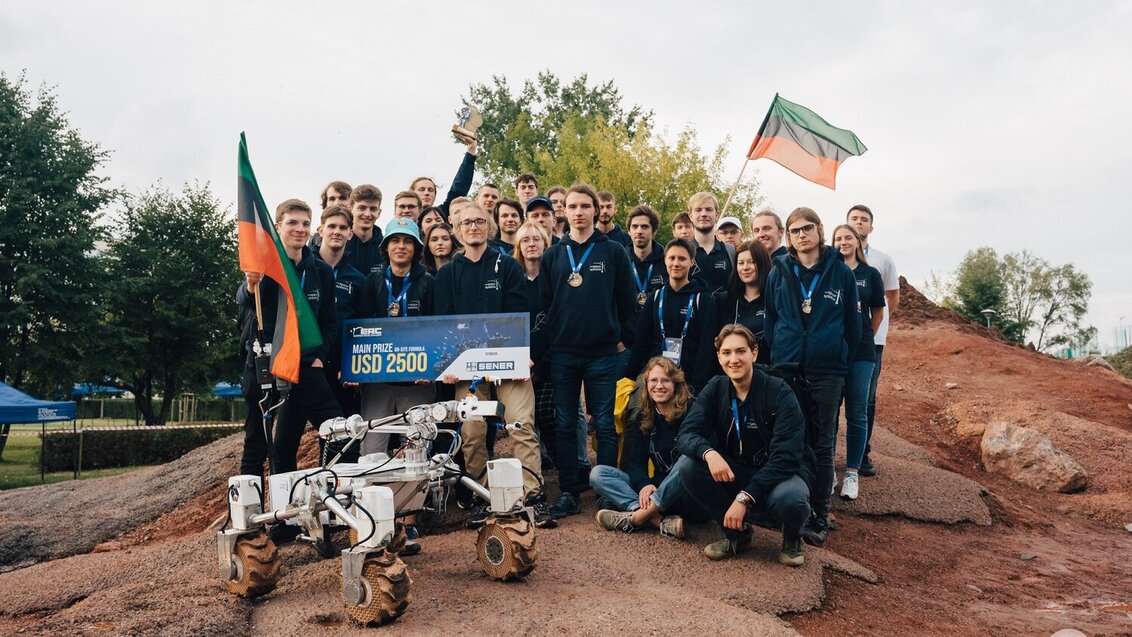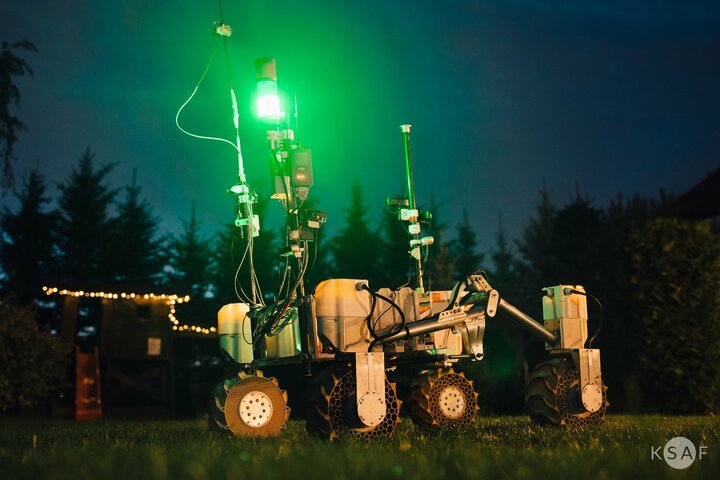The AGH Space Systems team won the eighth European Rover Challenge competition (in the on-site formula). In the grand finale, the team from our university bested 18 other teams from around the world, and the Kalman rover outdid its competition – it received as many as 88 more points than the rover classified as second in the general ranking. ‘This is a huge success for us because we’ve been competing in the ERC since 2016, but we had never managed to win it’, say the team members.
Competition
On the first day of the challenge, Kalman competed in three tasks. The first was the Science Task, which involved a precise scanning of the Mars Yard with cameras mounted on the rover. After completing the drive and establishing the position of distinctive landmarks on a map, the AGH Space Systems team analysed the footage and photos taken during the mission and reformulated their assumptions that they had made earlier about the area under scrutiny. The research plan and its effects were compiled in a Science Report, which was later submitted to the organisers for evaluation.
The next challenge was the Navigation Task, in which Kalman made use of its autonomous driving capabilities. The rover has made its way through the entire Martian terrain, reaching all designated spots without difficulty. The robot also succeeded in performing one of the most intricate parts of this task, that is, it returned to the starting point.
After sunset, our team approached the last mission planned for the day, i.e. the Probing and Collection Task. In a specified time, Kalman reached three pre-established spots and stuck in his special probes dismounted from its deck. The rover then made it to other points indicated on the map, from which it collected various soil samples. It placed each of the samples in a special container and weighed two of them in its laboratory. Thanks to its new grapples, which allow the rover to probe and collect soil samples during a single mission, the robot effectively used the 25 minutes allocated to this task. Furthermore, Kalman completed a large part of the challenge autonomously, winning the team some additional points.
The next day, the AGH Space Systems team participated in the only challenge that did not require the presence of a rover, that is, the Presentation Task. The research club representatives – Adam Zagrajek and Błażej Fiderek, gave a 20-minute presentation, during which they talked about the activity of AGH Space Systems, managing the rover project, and its subsequent iterations introduced. They did not have a problem mentioning their mistakes, as those are valuable lessons from which the team benefits the most. The entire team managed to answer even the most detailed question of the jury, often requiring specialised knowledge.
The final challenge was the Maintenance Task, which, due to weather conditions, was moved inside. Kalman, as the first among all competing rovers, had to face the suddenly changed mission environment. However, nothing could stand in its way. With the help of the operators, inverse kinematics, and autonomous 3D panel visualisation, the robot had no problem flipping all the switches, measuring the voltage in a socket, plugging in an Ethernet plugin, and attaching a magnet to a designated spot. Furthermore, Kalman done it all 10 minutes faster than the time specified in the rules and regulations of the task, scoring some bonuses for the team.
‘Rover Challenge competitions are always a summary of a multi-month work of our team. It is extremely tough and tiring to prepare for such events; it takes many sleepless nights. The members of our research club put their whole hearts into these projects, the effects of which could be seen during the competition’, said AGH Space Systems members. ‘We’re not even able to describe the joy and pride we feel!’
About the competition
European Rover Challenge is the largest space robotics competition in Europe. 19 exceptional academic teams from around the world have made it to the competition in the on-site formula and 11 in the remote one. The rovers competed on a specifically designed Martian track, the surface of which was inspired by a fragment of the Martian Plains Utopia Planitia and Elysium Planitia. The tasks prepared by the jury were meant to mirror the challenges that real Martian engineers would face.
The best three teams in the 8th ERC
On-site formula
- AGH Space Systems (Poland)
- EPFL Xplore (Switzerland)
- ITU Rover Team (Turkey)
Remote formula
- DJS Antariksh (India)
- Mars Rover Manipal (India)
- Project RED (Italy)
The co-organisers of this year’s ERC edition were the European Space Foundation, Kielce University of Technology, and the Marshall Office of the Świętokrzyskie Province. The host city was Kielce. The event took place under the honourable auspices of the European Space Agency, the International Astronautical Federation, and the Polish Space Industry Association.


 Pre-election meeting with a candidate for the position of rector
Pre-election meeting with a candidate for the position of rector  Agreement on cooperation with OPAL-RT
Agreement on cooperation with OPAL-RT  Krakow DIANA Accelerator consortium members with an agreement
Krakow DIANA Accelerator consortium members with an agreement  Meeting with the Consul General of Germany
Meeting with the Consul General of Germany  More Academic Sports Championships finals with medals for our students
More Academic Sports Championships finals with medals for our students  Bronze for our swimmers at Academic Championships
Bronze for our swimmers at Academic Championships  Smart mountains. AGH University scholar develops an intelligent mountain rescue aid system
Smart mountains. AGH University scholar develops an intelligent mountain rescue aid system